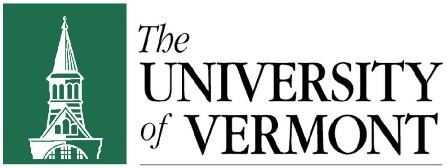 The University of Vermont (UVM) Physics Department has been an active member of the Nanoscale Informal Science Education (NISE) Network since 2008. Although very much an institution of formal learning, UVM values and contributes to informal education in the surrounding community. UVM has a long partnership with the ECHO Lake Aquarium and Science Center, but the NISE Network has provided an excellent framework to strengthen and deepen the collaboration between the Physics department and ECHO. UVM Physics and ECHO have worked together to put on six NanoDays events, science cafes, activities, and talks on nanoscience and other topics. The two institutions complement each other wonderfully, with the Physics department bringing graduate and undergraduate students, staff, and professors to facilitate NanoDays activities; and ECHO providing a comfortable forum for the public to interact with scientists, as well as training for those researchers on how to engage with the public. The public benefits from a deeper understanding of the science around them, and the scientists benefit from improved communication skills and a chance to share their joy about science.
The University of Vermont (UVM) Physics Department has been an active member of the Nanoscale Informal Science Education (NISE) Network since 2008. Although very much an institution of formal learning, UVM values and contributes to informal education in the surrounding community. UVM has a long partnership with the ECHO Lake Aquarium and Science Center, but the NISE Network has provided an excellent framework to strengthen and deepen the collaboration between the Physics department and ECHO. UVM Physics and ECHO have worked together to put on six NanoDays events, science cafes, activities, and talks on nanoscience and other topics. The two institutions complement each other wonderfully, with the Physics department bringing graduate and undergraduate students, staff, and professors to facilitate NanoDays activities; and ECHO providing a comfortable forum for the public to interact with scientists, as well as training for those researchers on how to engage with the public. The public benefits from a deeper understanding of the science around them, and the scientists benefit from improved communication skills and a chance to share their joy about science.
The department chair, Dennis Clougherty, has been an enthusiastic driver and supporter of the collaboration, serving on advisory boards for ECHO; as well as allocating time from the department to support activities at ECHO. In the past, this allowed senior technician David Hammond to coordinate students from the department and extend the NanoDays activities beyond the kit. While we can all agree that the NanoDays kit is a fabulous resource for science museums; Professor Clougherty’s support and Mr. Hammond’s hard work allowed UVM to bring and facilitate not just the kit, but other activities that tied directly to issues of local interest or research done at UVM in the Physics department and Materials Science Program.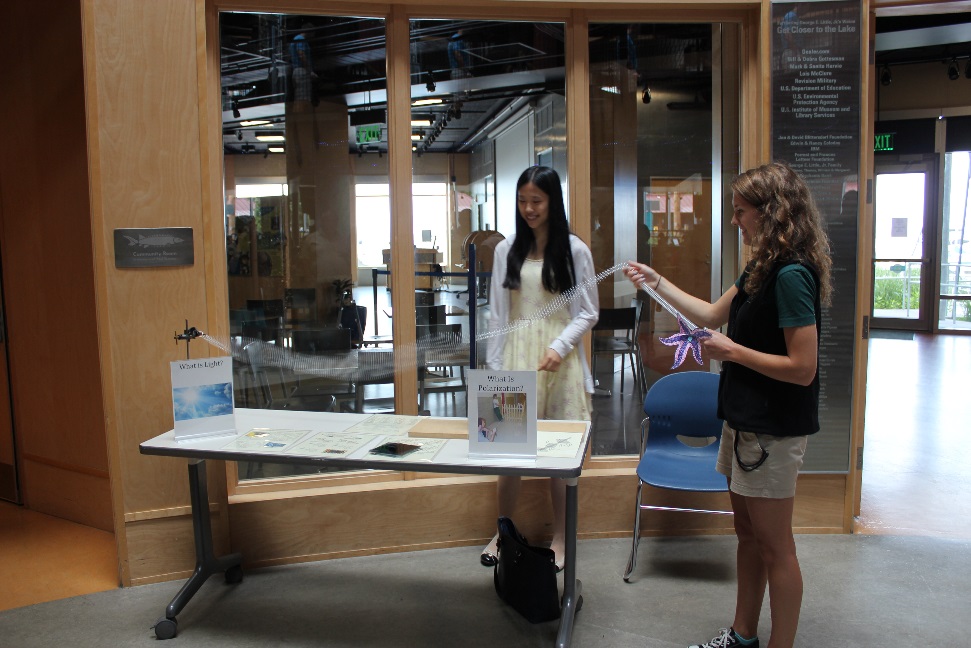
Picture Right: Generating a mechanical analogy of a polarized wave.
This past year, the UVM Physics Department and ECHO received a NISE Network mini-grant to develop an activity outside the purview of NanoDays. The ECHO Lake Aquarium and Science Center is charged with helping the public understand the Lake Champlain watershed, including facets of Education, Culture, History, and Opportunities for stewardship. The Physics department wanted to strengthen that mission by highlighting how basic science is a useful tool for investigating, understanding, and caring for the world around us. Light, and specifically polarization, gave us a unifying theme to bring a number of activities and concepts to ECHO. Visible light, something most museum visitors have experience with, has wavelengths in the hundreds of nanometers. This provides a comfortable entry point to familiarize visitors with "nano", and from there we can highlight how interacting with light at the length scale of its wavelength allows us to investigate both light and the world around us.
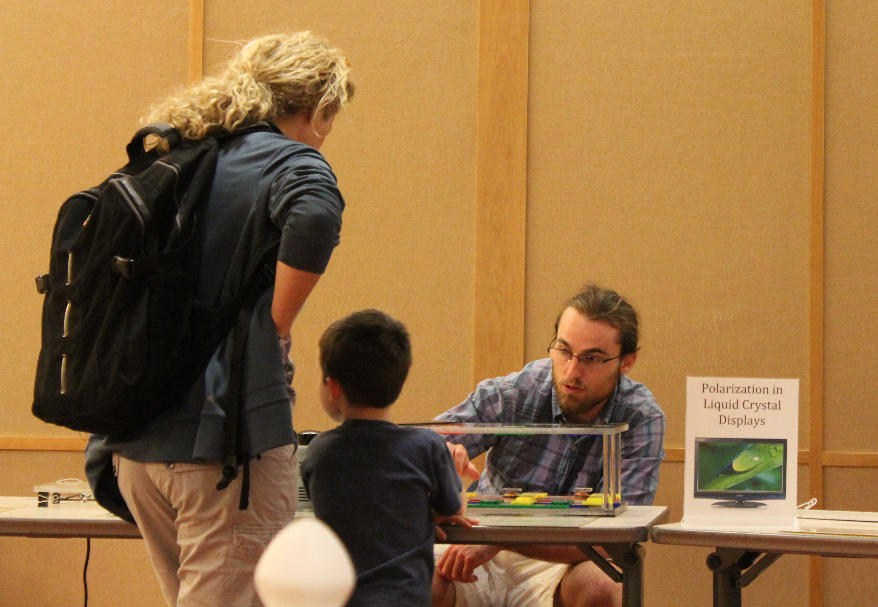 In addition to the bringing down a dozen graduate and undergraduate students to facilitate a day of bonus activities for the 400 museum visitors; Physics Professor Randall Headrick also came down to ECHO and gave two public lectures on light, its structure, and polarization. To reach more people, the talk was taped and made available online. Professor Headrick was able to discuss how the fundamental science principles the visitors were exploring were pertinent in his research on crystal structure, and also in their lives; such as what time the light reflecting off the lake will be mostly strongly polarized.
In addition to the bringing down a dozen graduate and undergraduate students to facilitate a day of bonus activities for the 400 museum visitors; Physics Professor Randall Headrick also came down to ECHO and gave two public lectures on light, its structure, and polarization. To reach more people, the talk was taped and made available online. Professor Headrick was able to discuss how the fundamental science principles the visitors were exploring were pertinent in his research on crystal structure, and also in their lives; such as what time the light reflecting off the lake will be mostly strongly polarized.
Picture Left: Visitors investigating how polarization is used in liquid crystal displays.
Polarization, the orientation of components of light, provides a tool with uses ranging from telling the time of day to monitoring invasive species in Lake Champlain. As an example of the later, Professor J. Ellen Marsden (an ichthyologist with UVM’s Rubenstein School of Environment and Natural Resources and long-time ECHO collaborator) supplied samples of larval zebra mussels from Lake Champlain. Zebra mussels, an invasive species actively monitored in the lake, are more easily distinguished and detected earlier with the thoughtful application polarized light.
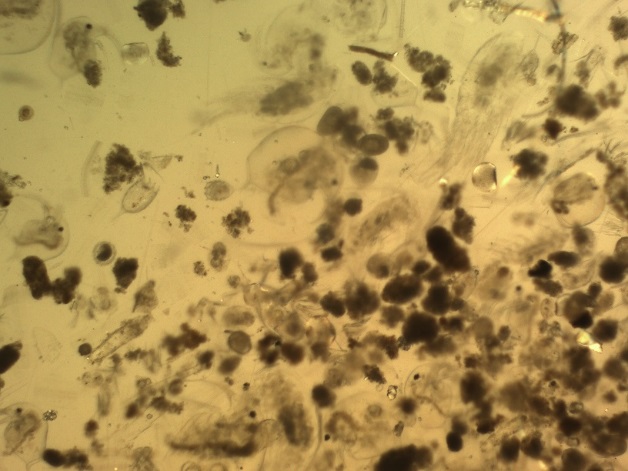
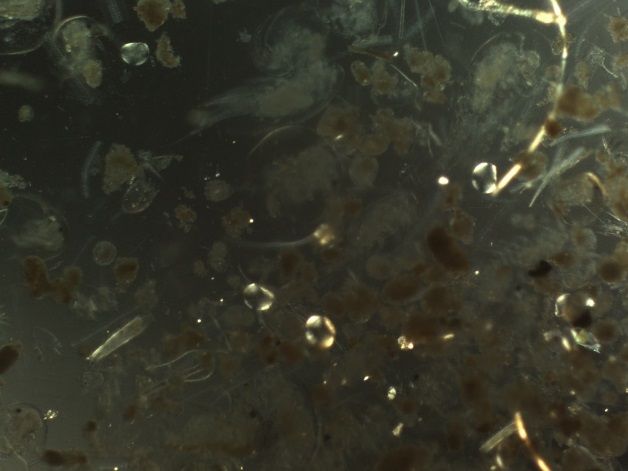
Two microscope views of the same sample from Lake Champlain without (left) and with (right) cross-polarized light filters. Zebra Mussel veligers stand out as the illuminated crosses in the right photo. (Photo credit: David Hammond)
Other applications of fundamental science principles ranged from the everyday (like sunglasses) through the artistic (creating murals and mica wall hangings) to engineering (stress analysis of materials). There is an online video tour of the activities here. The mini-grant brought together an interdisciplinary group of scientists and researchers from UVM to help tie together nanoscience, current research at UVM, and issues important to the local community. Both UVM and ECHO are grateful to the NISE Network for supporting their ongoing collaboration.
To learn more about NISE Net partner, The University of Vermont Physics Department, and their collaborative partnership with the ECHO Lake Aquarium and Science Center, contact Luke Donforth at [email protected] or Ali Jackson from Sciencenter, and the NISE Net Northeast Regional Hub Leader.
